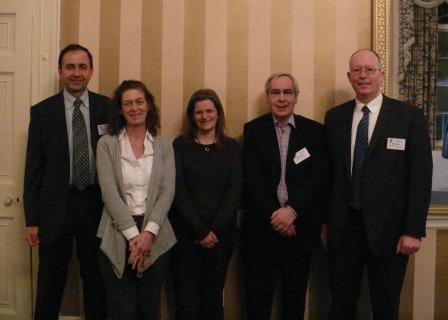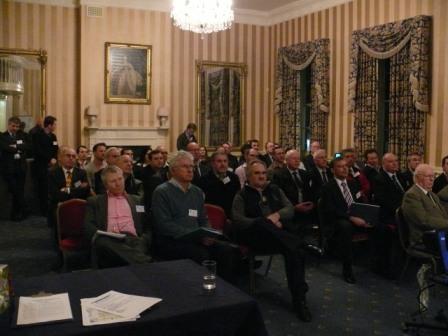ICT Evening Seminar
Arundel 1st March 2011
Bill Wilkie, ICT Technical Director, welcomed over 50 delegates to an evening meeting at the Norfolk Arms Hotel, Arundel. Bill reminded the delegates that the ICT is in its 37th year since it was founded. For the first time ever the ICT is holding an annual symposium which is free to members and will include a sit down lunch. The symposium is scheduled for 1st June at the Coventry Technocentre. The Annual Foundation Course in PCB Technology is being held from 11th to 15th April at Loughborough University and we have 20 delegates registered so far. This is a valuable course for newcomers to our industry to gain a comprehensive knowledge of PCB manufacturing processes. The ICT website has full details of this and future events. www.instct.org.
Bill also advised that the ICT has a key role in the administration and dissemination of a European research project – ASPIS. The aim of the project is to develop a more reliable ENIG surface finish. The web site has been launched and can be viewed here. www.aspis-pcb.org
| 1. |
The first speaker for the evening session was Tom Brown of Holders Technology. His paper was titled “FR4ever”. Download Presentation .4Mb pdf |
|
Tom explained we are an industry with process maturity. However, market forces are pushing the limits of accepted FR4 materials. There is an ever increasing demand for improved functionality from PCB's. Tom highlighted 2 examples. 75% of mobiles sold in Europe are now smart phones with highly complex PCB's. The production of high brightness LED's for solid state lighting is expanding rapidly. The application of solid state lighting produces significant thermal management challenges with heat output rising 10 fold from the accepted 4watts/sqin to 40watts/sqin. Tom reviewed the new aluminium clad substrates that have been developed with enhanced thermal conductivity. While there will continue to be many applications suitable for FR4 it is definitely not FR4everything! |
|
| 2. |
Our second speaker was Dr Ron Kirby of Arlon. His paper was titled “High Frequency Materials for RF Applications in Base Stations”. Download Presentation 5.5Mb pdf |
|
The introduction of 4G mobile phone technology is driving changes to base stations to cope with the higher data rates. We typically will see a downlink of 10-100 Mbps and uplink of 5-50 Mbps. There are predicted to be in excess of 7 million base stations in Europe by 2014. Cost is an important factor and commercial grades of RF substrates and PTFE for antennas are available. High performance RF materials are utilised in space and defence applications. Thermally conductive materials are a key factor. Typically a 10ºC rise in temperature reduces mean time between failures by 50%. Ron reviewed examples of ceramic filled low loss halogen free thermoset laminates which have 2x - 4x greater thermal conductivity and high copper peel strength at an affordable cost. |
|
| 3. |
The next paper, “Advances in Mechanical Micro-drilling” was presented by Chris Gerrard of Westwind. Download Presentation 11.0Mb pdf |
|
Chris reviewed the background of the PCB drilling market, the recent history of global manufacturing and the current worldwide distribution of production and sales. Also the current technology of spindles and machines, and an overview of the developments in spindle technology. Manufacturing of spindles is divided between UK and China. Mechanical drilling of 75µ holes is now available and 50µ drill bits will be available in 2016. Calculation of the peripheral cutting speed shows that spindle speeds in excess of 900,000 rpm will be required to achieve optimum drilling conditions! Optimum spindle speeds give longer tool life, less tool breakage, improved hole quality and higher productivity. The next generation of drilling machines will achieve 850 to 1000 hits per minute. They will need to be highly rigid and thermally stable. China is lagging behind Japan and Europe in producing machines capable of micro-drilling. There have been a number of established European and American drilling machine manufacturers who have closed as a result of not reacting to the market changes driven by China and Asia. Air bearing spindles can achieve very high rotational speeds. The next phase of spindle development will achieve 370k rpm using 2mm collets by 2012. Laser drilling is expected to dominate in the sub 50µ applications but mechanical drilling is a strong competitor in the 50µ to 100µ range. |
|
| 4. | “Making the Most of UL PCB Recognition” was the title of our final paper from Emma Hudson of Underwriters Laboratory. Download Presentation 1.5Mb pdf |
|
Emma gave a comprehensive review of the PCB categories that are recognised and the procedures for achieving product recognition for manufacturing facilities. Costs can be kept to a minimum by careful planning of process and temperature requirements. Reduced or no-test programmes are available for adding materials through the CCIL (copper clad industrial laminate) program. Emma demonstrated how the ULIQ searchable database can be used to optimise the recognition parameters for a PCB manufacturer. Similar cost savings can be achieved by using the Permanent Coatings Program for solder mask selection. UL listing cards can also be searched to match facility recognition with customer requirements. |
|
 |
|
 |
|
Bill Wilkie concluded the evening by thanking Gillian Herriot, Managing Director of Holders Technology, for sponsoring the event.
Richard Wood-Roe
ICT Council
5th March 2011
